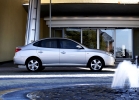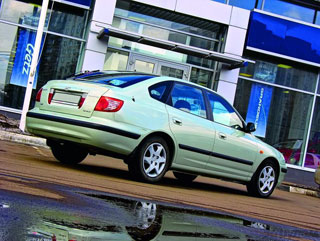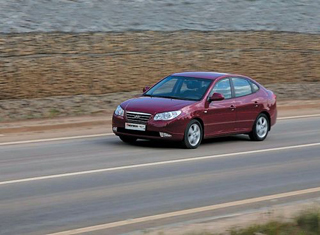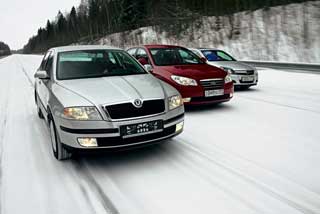Hyundai Elantra 4 doors for 2007 Sedan
They caught up and overtook
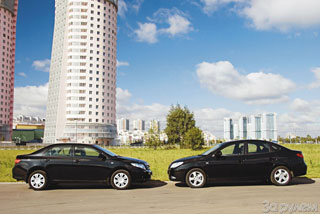 Voyota, heard about the outstanding qualities of Toyota cars, quickly chose quotas for the inexpensive Corolla sedans, making them with scarce goods the lines of dealers stretched for a year. However, for the same money and without a queue you can buy the Korean Sedan Hyundai Elantra. Is Corolla really better Elantra so that it should wait for a year?
Voyota, heard about the outstanding qualities of Toyota cars, quickly chose quotas for the inexpensive Corolla sedans, making them with scarce goods the lines of dealers stretched for a year. However, for the same money and without a queue you can buy the Korean Sedan Hyundai Elantra. Is Corolla really better Elantra so that it should wait for a year? In the hundreds of the most expensive brands in the world, Toyota takes 6th place (the best among automobile brands), Hyundai 72nd. Against this background, an almost fivefold lag in Elantra sales from Corolla does not look so dramatic anymore. However, the sales of the Japanese machine holds back the sluggish development of the dealer network, otherwise, according to many, Corolla could well count on the status of the absolute bestseller of the compact Class.
What attracts Corolla people? Price? Design? Good equipment? If so, then only partly. The main charm of buying Toyota in a sense of correct choice: the best automobile brand, legendary reliability, amazing durability, Japanese assembly. Corolla owners, like a spell, repeat these words and hear nothing about other cars. Japanese means excellent. Toyota means the best. The unpleasant aspects of possessing a car of this brand, like frequent and expensive, and high tariffs at the risk of casco of Corolla owners, seem to be not very worried. Many do not even suspect that insurance for other machines of this class is almost half as much and you can ride a service one and a half times less often, they just never thought that you can ride something else except Toyota. Rare car owners of this brand thought about buying other Japanese cars. Almost no one is transplanted to European or, God forbid, Korean cars with Toyota. Loyalty to the brand is simply fantastic. We love, want, buy. Need to wait? Let's wait.
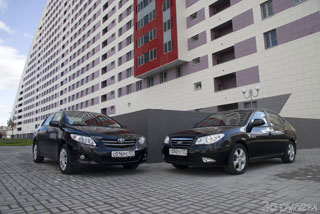 And if you still think about an alternative? In the end, the light on Toyota does not converge, and in neighboring car dealerships you can find many interesting cars. For example, Hyundai Elantra. It was developed specifically as a competitor Corolla: she has the same body type, similar configurations and engines close in power. We include the advantages of the availability of versions with a full hydromechanical automatic transmission, of which Toyota does not have (Corolla can only order robotic mechanics, which, with all the desire, cannot be called a worthy replacement for a traditional machine gun).
And if you still think about an alternative? In the end, the light on Toyota does not converge, and in neighboring car dealerships you can find many interesting cars. For example, Hyundai Elantra. It was developed specifically as a competitor Corolla: she has the same body type, similar configurations and engines close in power. We include the advantages of the availability of versions with a full hydromechanical automatic transmission, of which Toyota does not have (Corolla can only order robotic mechanics, which, with all the desire, cannot be called a worthy replacement for a traditional machine gun). For testing, we have chosen the most popular versions with 1.6-liter engines. The test Corolla was equipped with a robot, and Elantra with mechanics, however, we drove a 1.6-liter Elantra with an automaton earlier, so we’ll say a few words about it. The equipment in both cases is rich: four airbags (plus a pillow for the knee of the driver in Corolla), an audio system, climate control, heating seats and other small amenities. For a gentleman's set, unless the systems of dynamic stabilization of controllability on it for some reason decided to save on it: ESP is put only on the most expensive version of Elantra with a 2-liter engine, and for Corolla is not available at all.
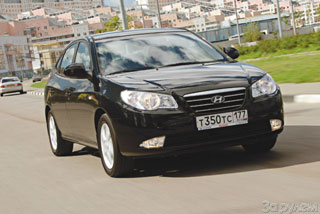 In the town
In the town To begin with, both cars are quite large. Yes, formally they belong to the so-called CD, but with their dimensions to count on easy parking or some special maneuverability in urban conditions. There are no problems with visibility: the outer mirrors on both machines are quite large, the front stands of the body are located successfully and the eyes do not call, the rear windows are wide, but they are entirely placed in the frame of the intra -tissue mirror.
The Corolla accelerated dynamics is impressive not sophisticated by supercars of the driver: the engine is roaring at high speeds, the robot with noticeable jerks switches the gears, the machine quickly gains speed. But this is in the sports mode of the robot, in the usual Corolla accelerates slower, but without jerking. The most serious drawback of the robot was revealed on the lifts: if it is even more or less on the hollow flyover, then he storms the steep slides like a hopeless teapot burning, rolls back and twitches. And nothing can be done with this: how the developers set up this cyborg, so it serves the inhabitants of the mountainous regions should think ten times before ordering
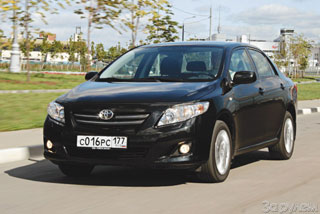 Corolla with RCP. Toyota steering in the city seems heavy to turn around with a minimum radius, you have to twist the steering wheel with two hands. It would be logical in this case to expect good information from the steering wheel, and it really is, but some kind of artificial, and with an increase in speed, the resistance of the mechanism increases stepped, which can be able to frighten the driver out of habit.
Corolla with RCP. Toyota steering in the city seems heavy to turn around with a minimum radius, you have to twist the steering wheel with two hands. It would be logical in this case to expect good information from the steering wheel, and it really is, but some kind of artificial, and with an increase in speed, the resistance of the mechanism increases stepped, which can be able to frighten the driver out of habit. Electric power steering on Elantra is more effective even in the parking lot of the steering wheel can be twisted with one finger. However, with an increase in speed, this lightness, unfortunately, almost does not disappear, the feedback is weak and the feeling of uncertainty in the car emerges. According to the dynamics of the Elantra acceleration with the automatic transmission, contrary to the numbers declared by the plant, it loses to the robotic Corolla, but the machine pleases with smooth switching.
Versions with mechanics are pleasantly surprised by the clarity of the gearbox and a more frisky acceleration, but upset the long -term, which grabs the clutch pedal at the very top.
In the vice of the metropolis, the general lack of duelists is the complete absence of the protective moldings of the body. Without them, of course, the cars look very elegant, but the slightest contact with solid bodies leaves scratches and abrasions on their bodies who are insured by the car along the CASCO, are doomed to regular chipboard calls with subsequent fixation of beatings and other bureaucratic ordeals.
In general, with urban exploitation, Elantra left a more pleasant impression: easy control and honest automatic transmission are better combined with a torn traffic light rhythm and the tightness of the lanes than the sports severity of the robot and the artificial resistance of the steering wheel in Corolla.
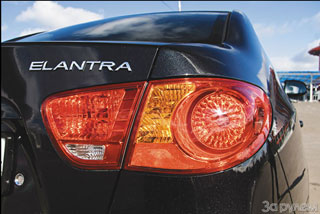 In the country
In the country A long ride along suburban roads with a hard coating of varying degrees of deterioration revealed the nuances in the smoothness of the passage of cars, which you do not pay attention to the city. In particular, Elantra copes better with the micro -relief, but grazes before large irregularities: it is easy to bring the suspension to breakdown, so that serious obstacles have to be seriously discarded speed. The four -speed ELANTRA automatic transmission does not have a manual mode, condemning the driver to develop intuition skills: to understand at what point after pressing the gas pedal will turn on, it is impossible to make overtaking inconvenient in a logical way. However, Hyundai experts provided the driver with an additional three modes of restrictions on the number of gear rates: you can prohibit the box switch above the first, second or third transmission. By transferring the selector lever to the desired position, you accordingly forcibly lower the gear and boldly go out to overtake it is not very convenient, although you can adapt. The exchange rate of Elantra is good, but too light the steering wheel does not allow the driver to relax for psychological calm, I want to hold it with both hands all the time.
Toyota Corolla has a more energy -intensive suspension, it is more pleasant to go on it on a broken country, but the texture of the roadway, alas, is felt better than in Elantra. The driver is not enthusiastic, but already from an uncomfortable chair (see in detail in the ergonomic section and comfort). What Corolla cannot be taken from is the ability to perform overtaking. The robot in this matter is the best friend and assistant, especially if you force him to switch the transfers for a compulsory order with the help of steering wheel petals: only one click, U1080 and the car instantly gains speed, dashingly bypassing the wagging trucks. The good on high -speed highways is also an artificially fascinated steering: the driver does not have to keep the steering wheel with both hands all the time, afraid to lose the car, the risk of accidentally knocking it out of the course is minimal. In a word, at large distances, Corolla city deficiencies turned into advantages outside the city of Toyota. Hyundai wins.
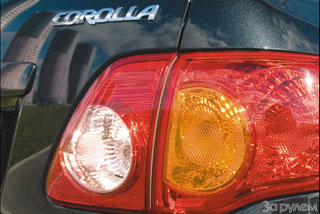 Controllability
Controllability In the absence of ESP, Corolla and Elantra drivers in difficult road conditions have to rely solely on their own strengths and professionalism of engineers who set up the chassis. Let's say right away, both Korean and Japanese specialists worked on fame, although their results turned out to be different. Elantra has a constructive advantage in the form of a multi -link rear suspension in corners with a bad road surface The car does not jump from the trajectory. But uninformative steering can repel from many drivers a desire to go quickly. However, despite the void, the steering wheel of Hyundai is quite accurate, and with a certain dexterity, a dynamic ride in a Korean machine can bring pleasure. The brakes are also good: the pedal is soft, but quite informative and allows the driver to accurately dose the brake force.
Corolla developers decided not to pamper the consumer with complex multi -native structures in the rear suspension, limiting themselves to a simple, but reliable and well -proven beam working for twisting. On the roads with a complex profile in the area of \u200b\u200bthe rear axle, some nervousness is felt, Corolla seems to jump a little on bumps, but it is quite confidently holding the trajectory, although it does not have the cleanliness with which Elantra turns. But there are excellent brakes and an elastic steering wheel with an electrical imprisoner cleverly simulating feedback. Let it work and not very natural, but for active driving it is better than the natural emptiness of the Hyundai helm. Another thing is that it is not interesting to drive aggressively to everyone, and from this point of view, both cars look equally attractive, so we give them equally good grades for handling.
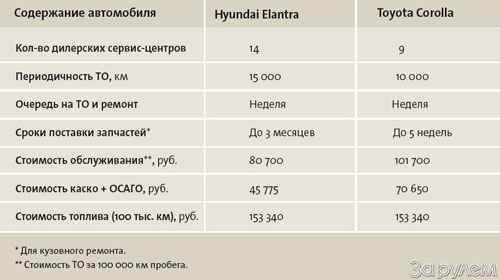 Ergonomics and comfort
Ergonomics and comfort The Elantra salon pleasantly surprises with the quality of finishing materials and good ergonomics: a convenient steering wheel, perfectly readable devices, large keys for the control units of the audio system and climate control. It can only be embarrassed by too bright blue illumination of the latter it is so caustic and can annoy on the road. The front seats are soft and completely unsportsmaning, but nothing is pressing anywhere, and even after a few hours of journey you get from them like fresh and rested from an orthopedic mattress. A low noise level and good suspension work on small irregularities on the highway are contributing to a high level of comfort no worse than some representatives of the premium segment. In the rear places, the legs and shoulders of the passengers are in relative freedom, but the heads of high entities almost rest against the ceiling for an elegant sloping roof.
Toyota Corolla has the body profile not so swift, but there are more space over the head of the passengers in the back seat, and the supply of arms and legs is the same as Hyundai. Sitting at the wheel less conveniently the Japanese widened the seat with a pillow: it is too badly littered and is not adjusted along the angle of inclination, which is why the back begins to hurt and the legs get tired. I remember that with the same problem we encountered VW Jetta. You can partially solve the problem by lowering the chair in the lowest position, but for low drivers this method is unacceptable. Beautiful concentric devices Corolla, honestly sketched at the Volvo S80, turned out to be uncomfortable: it is not possible to follow the peripheral vision after short arrows, and in order to control the speed, you have to take your eyes off the road all the time. But the amber backlight of the controls is good, as well as two spacious gloves in the front passenger department. But the quality of plastic (who would have thought!) In some places is inferior to Hyundai: the framing of the central tunnel with a duffel coffee and cup holders is made of rough rough plastic, and the structure itself walks with a stilt. In Elantra, this node is made more neatly and fixed stronger. It is slightly inferior to the opponent of Corolla in the smoothness of the stroke and the noise level, so that the Korean car wins in a comfortable nomination.
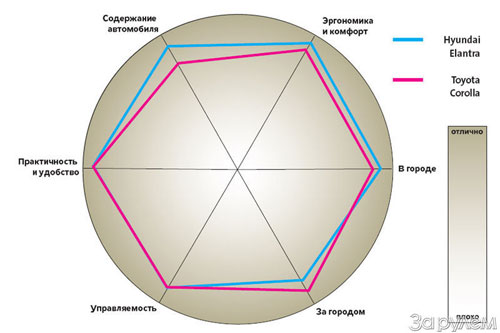 Practicality and convenience
Practicality and convenience The cargo capabilities of the rivals are approximately equal: the trunk volume according to the VDA method in Elantra is 460 liters, in Corolla 450. The backs of the rear seats are folded in a ratio of 2: 3 and fall on the pillows, forming an uncomfortable step with the lugger floor. Toyota is a little more opening with the embrasure, but Hyundai compensates for this omission by a more practical placement of the rear loudspeakers of the audio system: in ElanTra they nest in the rear doors and do not interfere with anyone, and in Corolla they are mounted in the shelf behind the rear seats, having shoe trunk. By wielding in a cargo compartment some large and hooked load such as skis, you can easily hurt the loudspeakers and, what kind of good, damage. In general, Corolla developers should cover this music with something, but otherwise everything is in order, no worse than that of the opponent. Parity.
conclusions
As a result, a very interesting picture emerges in our assessment diagram: Hyundai Elantra with a slight advantage wins the duel of Toyota Corolla. About five years ago, such a result would be unthinkable, and now please Hyundai learned to make good cars. Indeed, in sled qualities, capacity and comfort of Elantra and Corolla, they were very close, but the decisive advantage of the Korean machine provided lower maintenance costs: the popularity of Corolla turns into a very expensive insurance, and accusing insurance companies of abuse of correction coefficients is difficult to well be very popular of Japanese cars, even you crack criminal circles! In addition, the owner of Toyota has to go more often, however, unplanned visits to the Rembzone, judging by the reliability ratings TUV and J.D. Power, you will not have to do it. The cost is higher than that of Hyundai, but you need to remember that the funds invested in Toyota more than pay off when reselling: in the future, the 5-year-old Corolla will cost a significantly more expensive reputation and the value of the brand will definitely take their own.
Andrey Yezhov
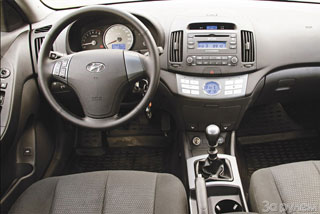
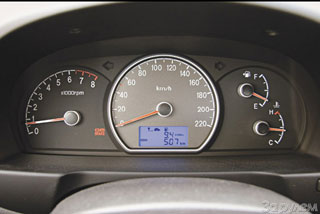
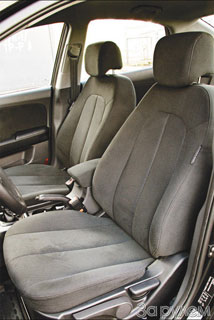
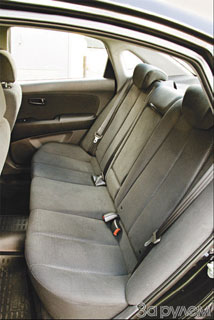
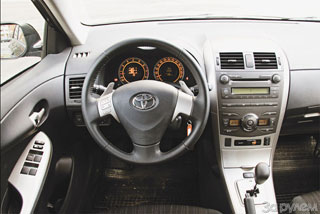
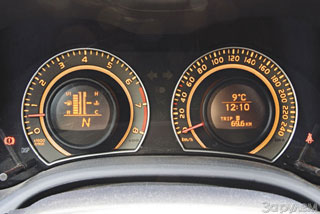
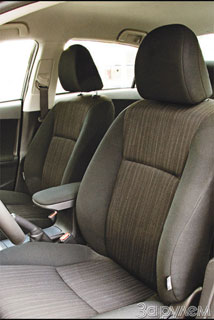
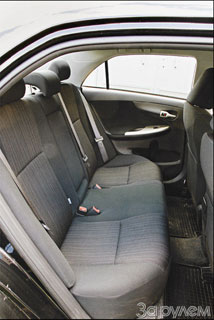
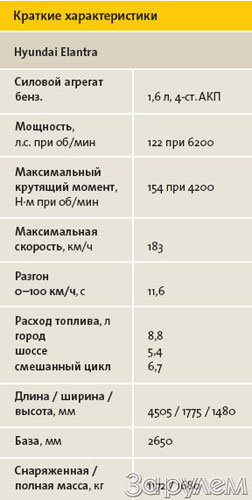
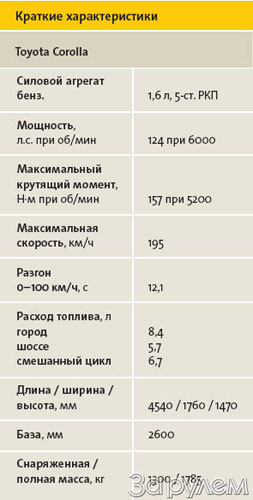
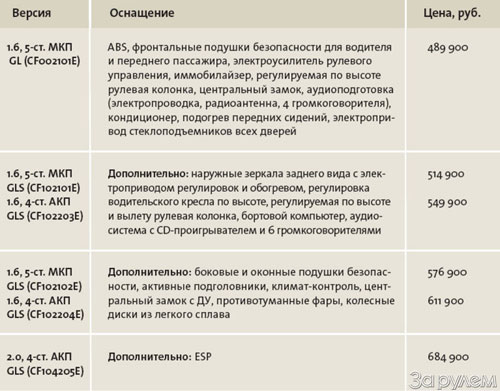
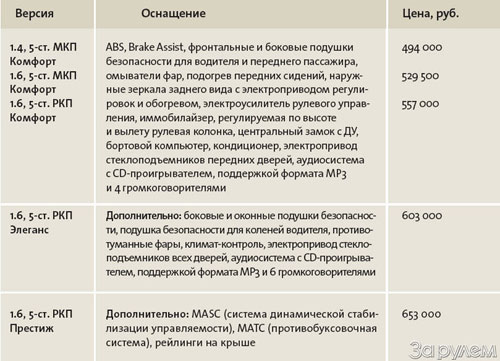
Source: Newspaper driving No. 38 2007


